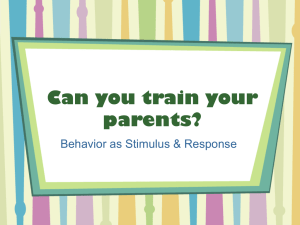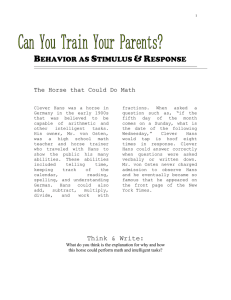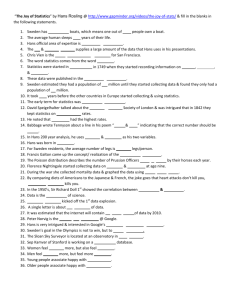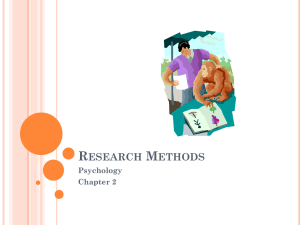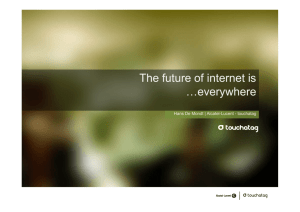Can you train your parents?
advertisement
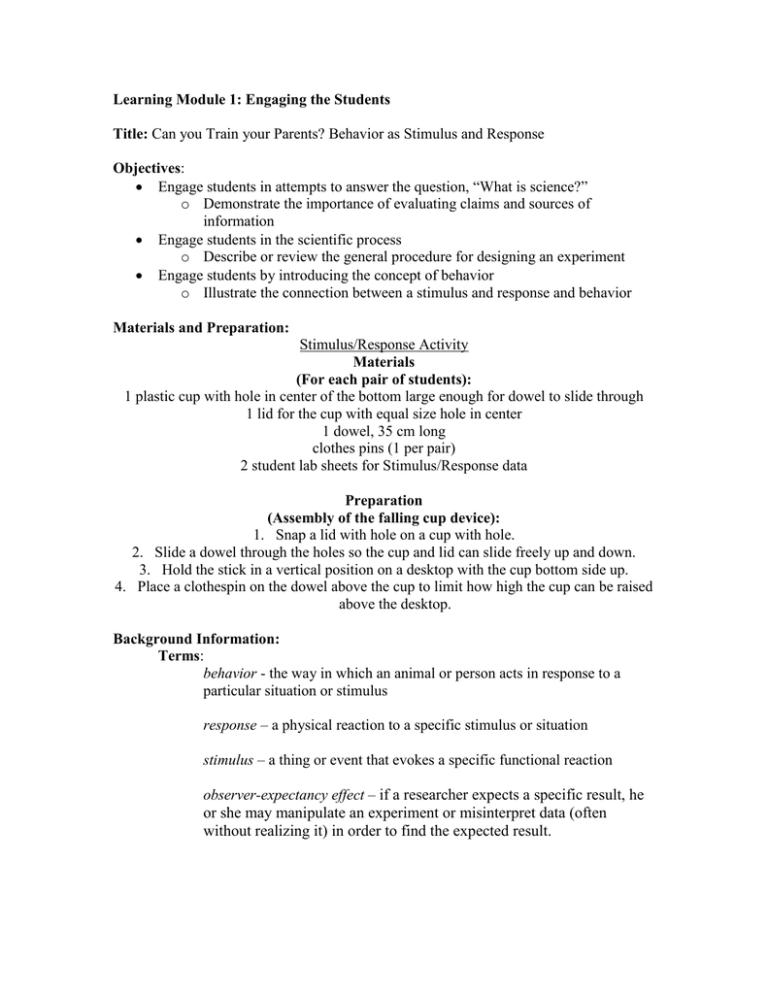
Learning Module 1: Engaging the Students Title: Can you Train your Parents? Behavior as Stimulus and Response Objectives: Engage students in attempts to answer the question, “What is science?” o Demonstrate the importance of evaluating claims and sources of information Engage students in the scientific process o Describe or review the general procedure for designing an experiment Engage students by introducing the concept of behavior o Illustrate the connection between a stimulus and response and behavior Materials and Preparation: Stimulus/Response Activity Materials (For each pair of students): 1 plastic cup with hole in center of the bottom large enough for dowel to slide through 1 lid for the cup with equal size hole in center 1 dowel, 35 cm long clothes pins (1 per pair) 2 student lab sheets for Stimulus/Response data Preparation (Assembly of the falling cup device): 1. Snap a lid with hole on a cup with hole. 2. Slide a dowel through the holes so the cup and lid can slide freely up and down. 3. Hold the stick in a vertical position on a desktop with the cup bottom side up. 4. Place a clothespin on the dowel above the cup to limit how high the cup can be raised above the desktop. Background Information: Terms: behavior - the way in which an animal or person acts in response to a particular situation or stimulus response – a physical reaction to a specific stimulus or situation stimulus – a thing or event that evokes a specific functional reaction observer-expectancy effect – if a researcher expects a specific result, he or she may manipulate an experiment or misinterpret data (often without realizing it) in order to find the expected result. double-blind – experiment in which any information that may influence the behavior of the tester or the subject is withheld until after the experiment Resources: The Skeptic’s Dictionary: Clever Hans Phenomenon http://skepdic.com/cleverhans.html Wikipedia: Clever Hans http://en.wikipedia.org/wiki/Clever_Hans School for Champions: How a Stimulus Results in Behavior www.school-for-champions.com/behavior/stimulus.htm Stimulus/Response Lesson Plan http://ed.fnal.gov/lincon/w98/projects/vitalsigns/stim-response.html Activities: Attention Getter Give each student a handout and begin the lesson with the following true story: The Horse that Could Do Math Clever Hans was a horse in Germany in the early 1900s that was believed to be capable of arithmetic and other intelligent tasks. His owner, Mr. von Osten, was a high school math teacher and horse trainer who traveled with Hans to show the public his many abilities. These abilities included telling time, keeping track of the calendar, reading, spelling, and understanding German. Hans could also add, subtract, multiply, divide, and work with fractions. When asked a question such as, “if the fifth day of the month comes on a Sunday, what is the date of the following Wednesday,” Clever Hans would tap is hoof eight times in response. Clever Hans could answer correctly when questions were asked verbally or written down. Mr. von Osten never charged admission to observe Hans and he eventually became so famous that he appeared on the front page of the New York Times. Think & Write: What do you think is the explanation for why and how this horse could perform math and intelligent tasks? What makes science valid? In groups: What explanations did you come up with? What do you think about your group’s explanations? Select one or two explanations to share with the class. As a class: Share explanations Go over the following qualities of a scientific experiment: NOTE: If your class needs a larger introduction or review of designing an experiment check out the reference article “Designing an Experiment” attached here, or online at http://www.longwood.edu/cleanva/images/sec6.designexperiment.pdf. The article references a book that you may also find helpful. Proving or disproving a hypothesis – Hypotheses may become theories once they are tested and proven. In order to prove (or disprove) a hypothesis an experiment must be designed and conducted. The experiment must be valid and manipulate, or test, the right variables. The factors of a valid experiment –A valid experiment has an independent variable, and dependent variable(s). There also may be factors that are held constant. In other words, these factors do not change. Manipulating variables –When testing the effect of an independent variable on a dependent variable it is very important that there is only one independent variable involved in the experiment. This ensures that when you change the independent variable it is the only factor that could possibly influence changes in the dependent variable. Several Sides—Back to Clever Hans Have students continue with the story of Hans and how experimenters tested his skills. The following is included on students’ handout. What the owner/audience thought: Clever Hans became famous during a time with Charles Darwin’s theory of evolution was gaining attention. Darwin’s theory suggested that certain intelligent and higher order tasks were confined to humans and higher life forms. In response, Mr. von Osten and others began to test this claim and were certain that Clever Hans was a prime counterexample of this idea. Clever Hans’ owner and audience believed that the horse had the ability to perform intelligent tasks as well as a human could. What experimenters’ found: The Hans Commission Because Hans was becoming so popular, the German Board of Education hired a commission to investigate Mr. von Osten’s claims. The goal was to determine if the claims were scientific or if they were the result of trickery. The commission was made up of 13 scientists, led by Carl Stumpf, a philosopher and psychologist. In 1904, the commission determined that there was no trickery involved in Hans’ performance. Oskar Pfungst The commission turned the investigation over to psychologist Oskar Pfungst, and in 1907, after formal investigation, he proved that rather than performing the tasks, Clever Hans was responding to the reactions of his owner and the audience. Pfungst tested Hans’ abilities by first isolating the horse and the questioner from an audience. This ensured that no cues were coming from the observers. Then, Pfungst used questioners other than Mr. von Osten. Pfungst also put blinders on Hans to vary whether he could see the person asking the questions or not. Finally, Pfungst varied whether the questioner knew the answer to the question. Hans answered correctly regardless of who the questioner was. However, the questioner had to know the correct answer and be visible for Hans to answer correctly. Following these findings, Pfungst studied the questioner’s behavior, and found that the questioner became tense (as evidenced by his posture and facial expression) as Hans’ taps approached the right answer. In addition, the questioner’s tension was released when Hans tapped the final, or correct, tap. Pfungst concluded that Hans was using a cue to know when to stop tapping. This effect, known as the Clever Hans effect, occurred even when the questioner had no idea he was provided such cues. Pfungst further demonstrated that this capacity to detect cues is not confined to horses, and that similar effects are just as likely in experiments with humans and other animals. Understanding this, scientists must be careful to avoid observer-expectancy effect and to make experiments double-blind. If time allows, lead students in picking apart what they have been told about Pfungst’s experiments. See the attached form taken from “Designing an Experiment” for examples of correct student answers. Testing Theories As we saw with Clever Hans, behavior can be determined by external cues. A more broad and common definition of behavior is a response to a stimulus. In order for a response to occur, a stimulus must be sensed, processed, and interpreted. First, living organisms rely on their senses to detect a signal. As humans, we use our sense of sight, hearing, smell, touch, and taste among others. Once a signal is detected, it is interpreted, and the organism responds or ignores the signal. Signals may be processed before the brain. This happens when you touch a hot stove. Signals may also be processed in the brain. Dogs do this when they begin salivating for a treat, after smelling the treat and realizing that it will taste good. Signals may also warrant complex interpretation. When you listen to a song, for example, your brain interprets the meanings of words rather than simply sensing and processing the sound. This may lead to an emotional response or a behavior. Responses come in a variety of forms as well. They can be positive, negative, or simply ignore a stimulus. A positive response would include a plant growing toward the sun. A negative response would be a plant’s roots growing around a piece of copper in the ground. An example of responding to a stimulus by ignoring it would be a dog ignoring sounds coming from a television. Activity: What are a stimulus and a response? In this experiment (adapted from the School for Champions: How a Stimulus Results in Behavior), students will use a falling cup device to depict a stimulus and a response. Students should record their response time in order to determine differences in responding with their dominant hand, non-dominant hand, with their feet, and with their eyes closed. Demonstrate the falling cup. Bring out the falling cup device and place it on a desktop in ready position. Release the cup and show how quickly it can fall to the desktop. Ask a volunteer to place a hand on the desktop right next to the dowel. (Stress that the responding student's fingers must be touching the dowel.) Ask the class if they think she will be able to get her hand out of the way when she sees the cup fall. Release the cup and let the student respond. * Reinforce that the sight of the cup falling was the stimulus and that the action of pulling a hand out of the way is the response Begin the Falling Cup Investigation. Have students gather data comparing the response of their left and right hands, their feet, and with their eyes closed. Data should be recorded as follows: Fill in the stimulus (vision) and the response (right hand) for the first data box. One person is the cup releaser; the other is the responder. Each time the responder's hand is hit, an X is recorded in the hit column; misses are recorded in the miss column. Allow students to conduct the investigation three times for dominant hand, non-dominant hand, foot, and with eyes closed. Remind students that the stimulus and response may change for each test. Think & Write: How could you test the stimulus and response principles of behavior with your pet or with a friend’s pet? Do you expect an animal’s responses to vary in a pattern similar to your responses? (For instance, would covering an animal’s eyes have the same effect?) Discuss the ideas regarding pets: What is some evidence (anecdotal) that stimulus and response principles can be demonstrated with pets? Reflection Depending on the time remaining, the reflection portion of each class may be done in class or at home. Think & Write: Based on what you have learned about Clever Hans and stimulus and response, design an experiment to test whether or not you can train your parents to do something (safe) that they don’t usually do.
